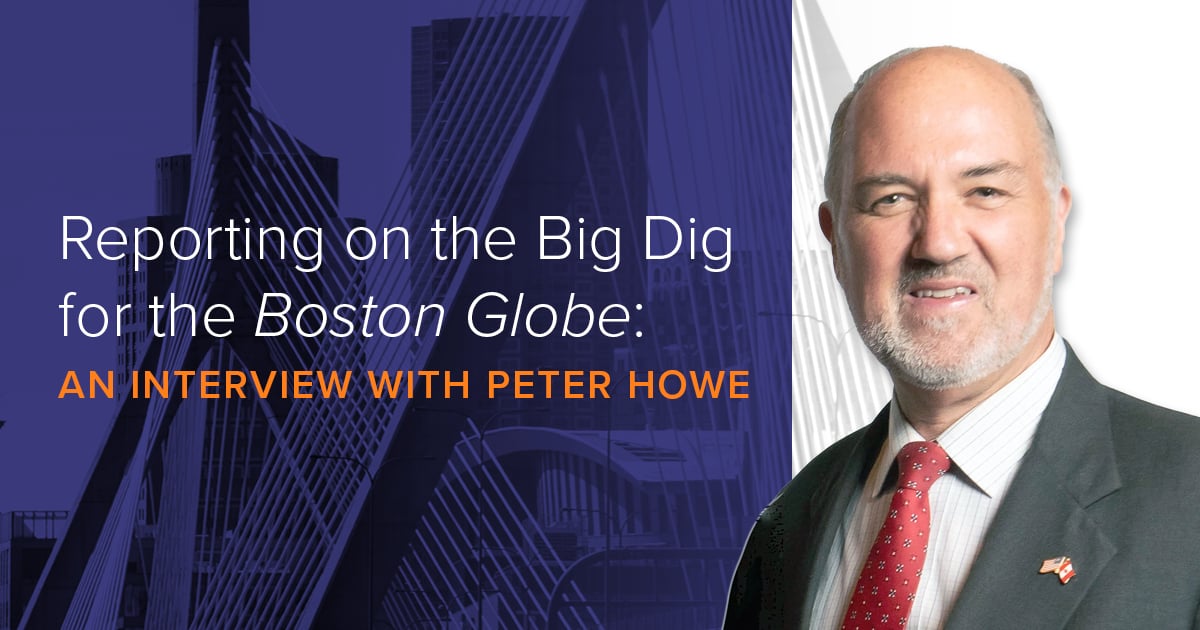By Katherine Adam

I’ve been riveted by the GBH podcast series, The Big Dig. It’s a stellar piece of journalism digging into all aspects of the megaproject – from Boston’s history of anti-highway activism to the privatization of public works to our region’s ambition to dream big with infrastructure.
For me as a communicator, one of the most compelling parts of the series has been the inside look at how the media approached coverage of the Big Dig. I was delighted to hear that the podcast included my colleague Peter Howe, formerly of the Boston Globe, who estimates he wrote roughly 400 stories on the project over seven or eight years – first as a transportation reporter, then as a State House reporter, then as a health, science, and technology reporter.
Following up on his podcast appearance, I asked Peter some further questions on media coverage of the Big Dig and how the project continues to shape public conversation about transportation in the region.
- What were your first thoughts when you heard they were doing a podcast on the Big Dig?
Excited, curious to see whom they would choose to interview, amazed to realize that covering this story was literally half a lifetime ago. Worried about revisionist history seeping through—but I credit [producer] Ian Coss and his team for doing a superb job of finding all the right people to interview and bringing smart, journalistic skepticism and balance to building the podcasts.
- How do you think the Big Dig would be covered in today’s media landscape?
Inadequately, and with a huge amount of Big-Dig-controlled and -generated coverage of itself pushed across social media and sponsored channels.
In the late 1980s and early 1990s, there were, I would estimate, something like 5 to 10 times as many working journalists in Greater Boston as there are now, including dozens of reporters at the State House and vastly larger staffs at the Globe, Herald, Boston Business Journal, CommonWealth Magazine, and a trove of strong regional papers like the Patriot-Ledger and Lowell Sun and vibrant local weeklies. We had far more journalists producing journalism, with each one much freer to focus more sharply and dig more deeply than today’s wildly overworked newspeople. I fear if I were covering the Big Dig today for the Globe, it would be one of about five “beats” I’d have to juggle simultaneously.
We also live in an era in which big companies’ and big organizations’ ability to convey their own messages in exactly their own terms, through promoted social media and purchased TV and radio airtime and other direct channels, is orders of magnitude more powerful than it was 30 and 35 years ago. In 2023 America, I can imagine that Bechtel/Parsons Brinckerhoff [the giant consultant to whom management of the Big Dig was outsourced, with mixed results] would own and operate its own newsroom cranking out 20 times the “coverage” the Globe, Herald, BBJ, State House News Service, and local TV could manage. As a PR guy, I gotta say, I love the opportunities for my clients—accurately and ethically, we always insist—to get their messages out in exactly the ways they want them framed and expressed. That said, the journalist and citizen in me, however, appreciates the accountability created by independent media.
- Looking back, would you have changed anything about your approach to reporting on the project?
Been more fearless about brushing off all the attempts to spin and squelch my coverage that came from very powerful political and business interests. Back when you had to use a phone or go to someone’s office instead of trading emails, I wasted a lot of time agreeing to interviews with multiple people who had obviously been commissioned by the Big Dig and its boosters to repeat the exact same sets of talking points and criticisms.
What I remain intensely proud of: I was the Boston journalist who actually read all 11 volumes–thousands of pages–of the project’s Environmental Impact Report/Statement … and then wrote, over and over and over again, about what I had found, the reality of the project’s complexity and impacts, and the many concerns it raised for everyone from neighborhood activists, the Boston Fire Department, and businesses like Hook Lobster and the Haymarket pushcart vendors, to the Pine Street Inn, the region’s biggest provider of services for people experiencing homelessness.
- Do you think the Big Dig’s legacy still influences media coverage of transportation?
I think, unfortunately, the massive cost overruns of the Big Dig and the miserable experience most motorists have driving through it every day have cemented a defeatist philosophy that has also infected the MBTA and regional highway and transit upgrades. The conventional wisdom gleaned from the Big Dig seems to be: Boston, and Massachusetts, just can’t do big transportation projects well, on-time, and on-budget.
Many of us who count on and love the T have been astonished to see that the result of years of investing billions of dollars in the T has been until only very recently … making the T worse! Slow zones, longer wait times between trains, new tracks built too narrow (Somerville/Medford extension), trains that catch on fire, a subway-train factory in Springfield that can’t make subway trains, panels falling from station ceilings and nearly killing people, and even a rider death on the Red Line.
It’s as if, ever since Governor Michael Dukakis left office having created an MBTA that worked reasonably well and the Big Dig then overtook every aspect of transportation planning and funding and management in Massachusetts, we live under a curse. Post-Big-Dig, the basic frame through which the Globe and other Massachusetts media seemingly approach covering transportation is: We can’t do this well, and we’ll probably fail when we try.
I feel very encouraged about the most recent progress and new transparency at the T. But nearly two decades after the Big Dig finally lurched to its end, we still have enormous work to do to regain the confidence of the public and the press that Massachusetts can make progress in creating the transportation network we need and deserve.
Denterlein Senior Vice President Peter J. Howe joined the firm in 2016 after a 30-year career in journalism at The Boston Globe and New England Cable News as on-air Business Editor. At Denterlein, his work has included helping clients produce feature articles and columns about complex infrastructure projects for dozens of publications including American City and County, North American Clean Energy, Railway Age, Solar Power World, and Stormwater Solutions.

